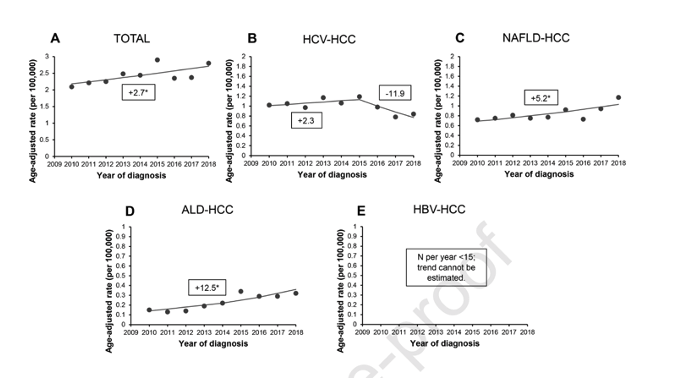| |
Incidence of Etiology-specific Hepatocellular Carcinoma:
diverging trends and significant heterogeneity by race and ethnicity
|
| |
| |
Download the PDF here
sept 5 2023
Paulo S. Pinheiro, MD, PhD, Patricia D. Jones, MD, MSc, Heidy Medina, PhD, MPH, Hannah M. Cranford, MPH, Tulay Koru-Sengul, PhD, MA, MHS, Tim Bungum, DrPH, Robert Wong, MD, MS, FACG, Erin N. Kobetz, PhD, MPH, Katherine A. McGlynn, PhD
HCV remains the leading cause of HCC among men, but since 2017 NAFLD-HCC is the leading cause among women. HCV-HCC AAIRs are particularly high among US-born minority men, including Puerto Rican (10.9 per 100,000), African American (8.0 per 100,000), and US-born Mexican American men (7.6 per 100,000).
Hepatocellular carcinoma (HCC), representing 78% of liver cancers in the United States (US), is highly fatal with only 18% of patients surviving 5 years [1]. Approximately 25,000 new HCC cases are diagnosed annually and incidence rates have increased 48% since 2000 [2]. Clinician reports have shown that over 90% of HCC cases can be attributed to a particular etiology, with the most prevalent causes being chronic hepatitis C infection (HCV), chronic hepatitis B infection (HBV), alcohol-related liver disease (ALD), and non-alcoholic fatty liver disease (NAFLD) [3,4]. Yet, the respective burden of each distinct cause of HCC in the diverse US population is poorly understood, a knowledge gap that hinders our ability to develop effective prevention and control efforts, especially for the non-infectious causes of HCC. HCC is a cancer that disproportionately affects those of low socioeconomic status, as well as immigrant, Veteran, and incarcerated populations [4].
Abstract
Background & Aims
The main causes of hepatocellular carcinoma (HCC) include chronic hepatitis C and B viral infections (HCV, HBV), NAFLD, alcohol-related disease (ALD). Etiology-specific HCC incidence rates and temporal trends on a population-basis are needed to improve HCC control and prevention.
Methods
All 14,420 HCC cases from the Florida statewide cancer registry were individually linked to data from the hospital discharge agency and the viral hepatitis department to determine the predominant etiology of each case diagnosed during 2010–2018. Age-adjusted incidence rates (AAIR) were used to assess the intersection between etiology and detailed race-ethnicity. Etiology-specific temporal trends based on diagnosis year were assessed using Joinpoint regression.
Results
HCV remains the leading cause of HCC among men, but since 2017 NAFLD-HCC is the leading cause among women. HCV-HCC AAIRs are particularly high among US-born minority men, including Puerto Rican (10.9 per 100,000), African American (8.0 per 100,000), and US-born Mexican American men (7.6 per 100,000).
NAFLD is more common among all Hispanics and Filipinos, HBV-HCC among Asian and Haitian Black men. HCV-HCC surpasses HBV-HCC in Asian women. ALD-HCC is high among specific Hispanic male groups. Population-based HCV-HCC rates experienced a rapid decline since 2015 (-9.6% annually), while ALD-HCC (+6.0%) and NAFLD-HCC (+4.3%) are rising (p<0.05).
Conclusions
New directly acting anti-viral drugs have impacted rates of HCV-HCC, offsetting important increases in both ALD- and NAFLD-HCC. Hispanics may be a group of concern due to higher rates for ALD- and NAFLD-HCC. HCC etiology varies remarkably and may warrant specific interventions by detailed race-ethnicity.


| |
| |
| |
|
|
|